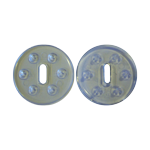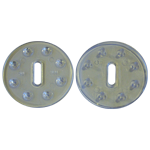Q: I have a spectra mainsail on a Santa Cruz 52 that has a Dutchman system in need of a refit. It has plastic grommets where the monofilament passes through the sail which appear to be glued on. Some of these are missing. Are they necessary? Can they be replaced? How are they glued?
A: The older (milky white color) nylon fairleads were glued together using a surface adhesive, with a drop of cyanoacrylate on the pins. The new fairleads are clear polycarbonate, with protruding sharp pins that are hammered down, along with the same surface adhesive (3m 9485). These new fairleads have proven to be more reliable, and you can easily inspect that the pins are properly secured (the sharp pins will be mushroomed over). We know of several cases where sailmakers did not use the supplied Cyanoacrylate Glue with the older fairleads, which will cause the fairleads to fall off in time. The uppermost fairleads should be a diamond patch with a #4 or #5 grommet if the luff of the main is much over 40 feet. Some spreaders have sharp aft edges, which can pull off the fairleads if the sail is raised or lowered against the spreaders. A slight radius on the aft edge of the spreader will solve this problem, and is better for the sail. The older fairleads can be temporarily glued back together with Crazy Glue brand of cyanoacrylate. The original formula (not the gel formula) worked the best in our tests. This will not last long.
The control lines will need to be pulled out (and this is a good time to replace them!) to install new fairleads. If the mono control lines are in good shape, you may want to tape a messenger to end to pull the line back through the sail after the new fairlead has been installed. To install the new fairleads, you need a rubber mallet, a smooth face steel hammer, and a short 2×6 or 2×8 to work on. You first remove the release paper and install the male fairlead from underneath, then apply the female fairlead (again, pull the paper backing) and set it with a rubber mallet. Then use the steel hammer to peen over the protruding sharp pins. The wood can be placed on top of the boom to provide a working surface. The fairleads are needed, or the line will damage the sail in stronger winds. They should be 2.5″ with 8 pins. [togglegroup][toggle title=”click to buy fairlead replacement parts”]
 (6 hole) Mainsail Fairleads (one pair) for 40 Series System (one pair) / SKU P-Fairleads MED [cc_product sku=”p-fairleads-med” display=”inline” quantity=”true” price=”true”]
(6 hole) Mainsail Fairleads (one pair) for 40 Series System (one pair) / SKU P-Fairleads MED [cc_product sku=”p-fairleads-med” display=”inline” quantity=”true” price=”true”]
(8 hole) Mainsail Fairleads (one pair) for 50 Series System (one pair) / SKU P-Fairleads LRG [cc_product sku=”p-fairleads-lrg” display=”inline” quantity=”true” price=”true”] Fairleads / Kits & Parts
Q: Your thoughts regarding Spectra
A: Spectra has advantages (great UV resistance — long life and low friction) and some disadvantages (cost, will pick up more dirt than the smooth surface of nylon monofilament). Main disadvantage is that it is too strong. If it catches on something like a backstay, spreader or runner during a jibe, the sail will be ripped. Mono will break normally before sail is damaged. The most common issue happens when the sail is reefed incorrectly, and is not pulled flat as it should be. Typically the aft reef line is not pulled tight enough, either because of friction, or because the mainsheet, vang and boom brake have not been all been released. In this case the topping lift and control lines will be tight, and there will be wear and chafe until the control lines break.
Q: Should I just take the sail to one of your recommended lofts and have them work with you on the layout given that I provide all the mast, boom spreader dimensions? I will probably install the system myself.
A: Yes
Q: Do the existing slugs (mast and boom) really need to be removed?
A: Not at all. We try to keep all the slides. The boom slides certainly will not be moved, although most of the systems are installed into loose footed sails. The luff slide spacing does need to be even.
